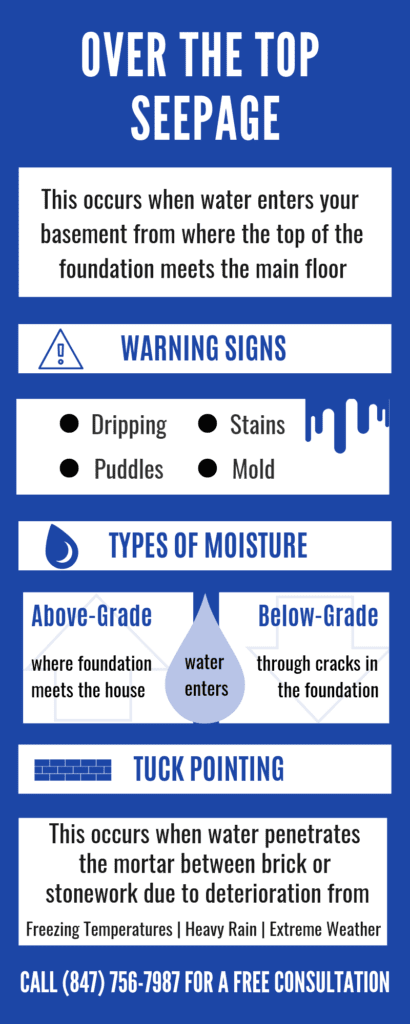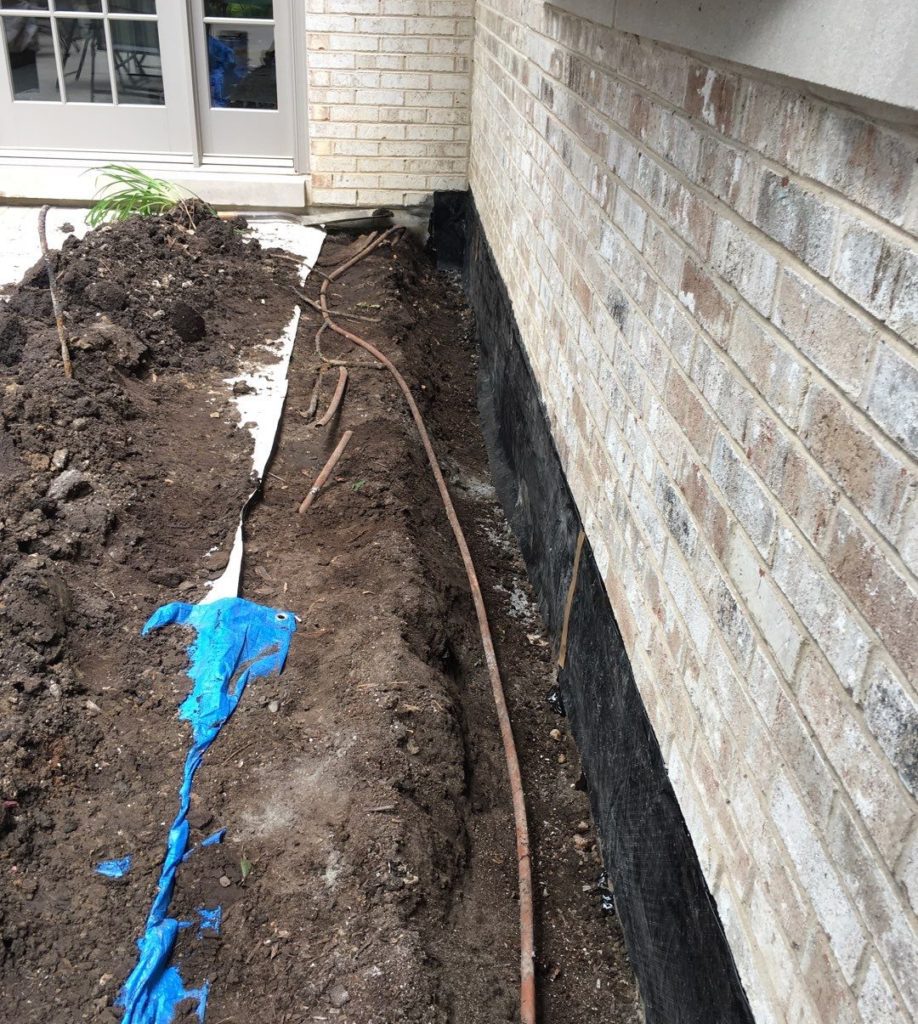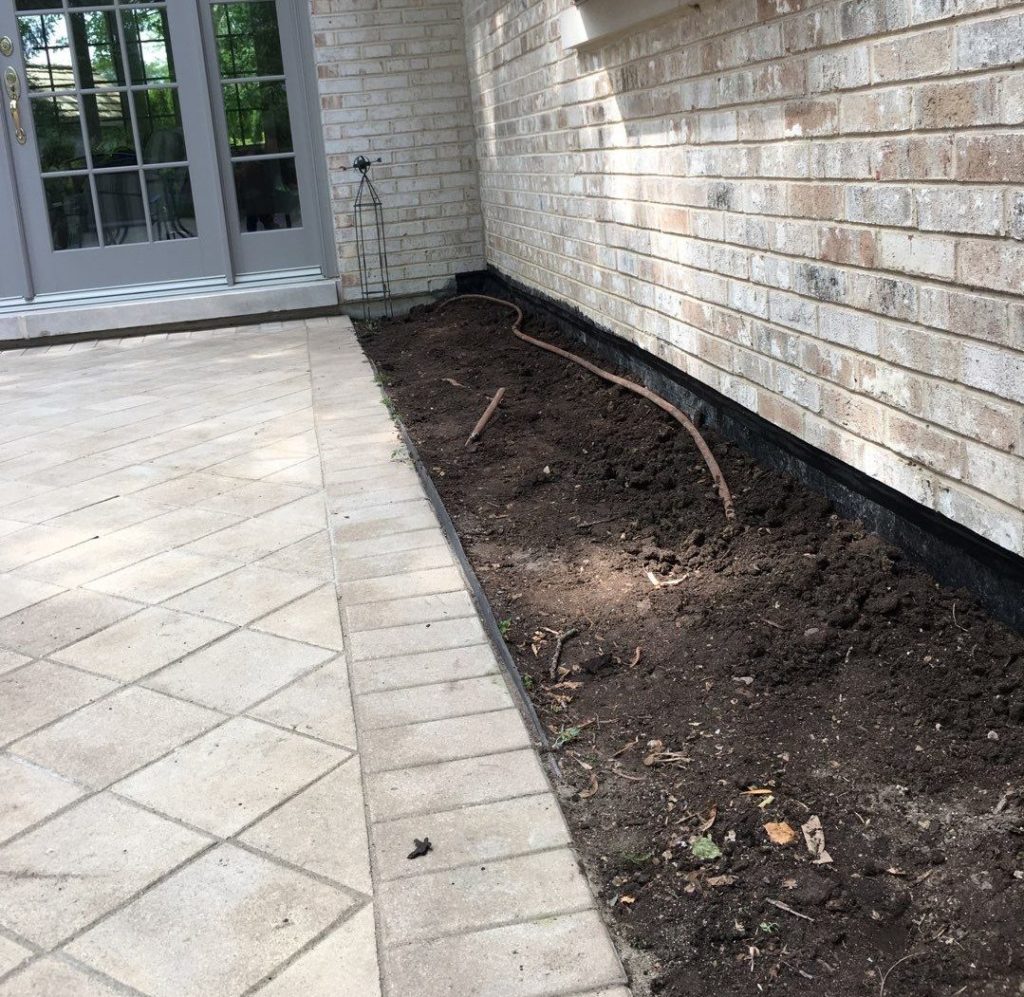Over The Top Seepage
As winter snow finally melts and spring storms bring tremendous amounts of rainfall, leaky basements become a common problem. When homeowners find water in their basement, their initial thought is usually that it got in through cracks in the wall or floor.
However, in some cases, water may come into the basement from over the top of the foundation where it meets the main floor of your home. This commonly happens when the grading on the outside of the house causes water to pool next to the foundation. Many times, foundation seepage can be fixed by having a landscaper come to re-grade the dirt away from the home.
The top of the foundation should extend above ground level by a few inches at the very least. However, aesthetic additions—such as brickwork and landscaping—create the perfect opportunity for water to seep over the top of the foundation wall. This problem is amplified even further when you’re located in an area on lower grounds.

Some Potential Warning Signs of Foundation Seepage are:
Dripping
One of the most common signs is water dripping down the walls from the top of the foundation.
Puddles
If you notice puddles forming near the wall and cove joint or near the foundation wall after a big storm, you may need a foundation seepage repair.
Stains
Stains on your basement walls are another typical symptom of this issue.
Mold
When moisture continually runs down your walls, you may notice mold growing in those damaged areas.
Types Of Water Seepage
Significant amounts of moisture constantly resting against your foundation puts a ton of unnecessary pressure on the walls. If left unattended, it will eventually break through the seal you have in place and start to run into your basement. There are two types of moisture concerns to take note of when you’re dealing with a basement leaking at the top of the foundation wall:
Above-Grade Moisture:
This occurs when water comes in where the foundation meets the house.
Below-Grade Moisture:
This happens if the water is coming in through cracks in the foundation. If this is the case, you’ll notice moisture saturation whenever it rains.
If you’re dealing with a basement leaking from the top of the foundation wall, you may need to consider exterior waterproofing options as opposed to interior ones. Many people with fully finished basements prefer this option as it gets the job done without causing any harm to the interior. During your complimentary consultation, we’ll be able to tell you the exact type of issue at hand and better guide you toward potential solutions.


Tuck Pointing
Fireplace & Chimney Foundation Sealing
One of the weirder places you will see water coming in is through HVAC ducting lines, many of which go into the Fireplace stack. These vent lines deal with the Carbon Monoxide and exhaust discharged from the systems. Water can come in from around the edges of the pipe where it enters the wall. You will see it drip down the wall, and sometimes even get in the pipe and drip on your Water Heater and Furnace.
Here’s the tricky part. There is not just one way for water to come in through those pipe penetrations into the Chimney Stack. This water can be caused by one, or more of the following issues:
- Foundation Crack in Chimney Foundation
- Tuck Pointing Issues in Chimney Above the Ground
- Flashing Issues with the Siding
- Chimney Sill on the top
- Chimney Cap
So how is someone going to determine the source of the water if it could be coming from 5 or more places? Frustrating, we know. Especially when they all produce water in the EXACT same place. Like anything, we need to perform a step-by-step process of elimination in order to determine the source of the leak. The process looks something like this:
- Chimney Cap & Sill to be checked for good condition: A homeowner may already know this, especially if they had work done recently. If they are unaware of the condition of either of
- Flashing Issues Inspected: Flashing against the Chimney can be easy to spot many times. Especially as there should be a caulk seal against the Chimney, if it has moved or pulled away, remnants of it can still be seen. Any seals/openings are recommended to be sealed by a professional.
- Tuck Pointing Issues: You would be surprised at how a small hole in the mortar joints between the brick can cause water seepage inside. More to the point, these small holes can cause a LOT of water. Even Tuck Pointers argue depending on the size of the hole, but this is where a hose test is effective.
- Foundation is Inspected for Cracks: With the top of the foundation exposed, or a little digging, we can identify Foundation Cracks from the top in most cases. There are a few cases where the crack is horizontal and unable to be identified from the exterior or interior. What then?
Process of Elimination for Foundation Seepage Repair
How Much Does Foundation Seepage Repair Cost?
Foundation Sealing, Exterior Sealing, and Over-The-Top Foundation Seepage Repair are all in the same category. These issues can be repaired with several different solutions:
- Sealing of Foundation where it meets Brick/Stone/Block siding
- French Drains and Water Management
- Sealing of entire Foundation Wall (Drain Tile Needed, read below for more)
- Sealing between Sidewalk/Concrete and Foundation Wall or Brick/Stone/Block siding
- Tuckpointing
- Window Seals
- Flashing
- Chimney Cap
Foundation Seepage Repair Where It Meets Brick, Stone, or Block Siding
This is usually done because the top of the Foundation Wall is below grade/ground, which causes water buildup to wear away the mortar joints and allow water to come in. This is repaired with a Elastomeric Waterproofing Tar. This is applied on the top couple inches of the Foundation Wall and then a couple inches above the ground level.
French Drains and Water Management
Sealing of Entire Foundation Wall
Tuck Pointing/Window Sealing/Flashing/Chimney Cap
Warranty
Check our pricing sheet to learn more about costs. We also offer services such as concrete leveling and crawl space encapsulation in the Chicago area.
REQUEST A FREE ESTIMATE

DOWNLOAD OUR FREE GUIDE
We created a guide titled:
“A Homeowner’s Guide to Basement Waterproofing” to help you spot common basement issues around your home and learn how to fix them. Enter your email and get the free guide.
“Not Everything’s Better When Wet”®
